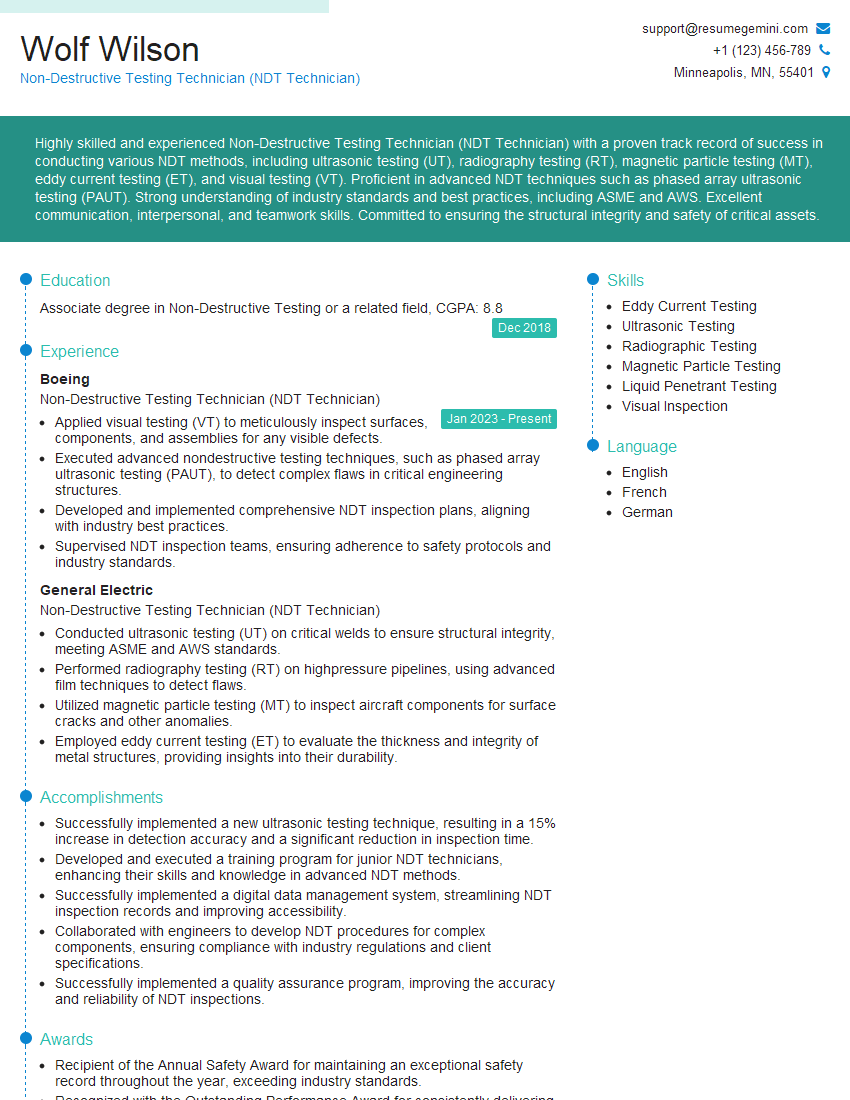Are you a seasoned Non-Destructive Testing Technician (NDT Technician) seeking a new career path? Discover our professionally built Non-Destructive Testing Technician (NDT Technician) Resume Template. This time-saving tool provides a solid foundation for your job search. Simply click “Edit Resume” to customize it with your unique experiences and achievements. Customize fonts and colors to match your personal style and increase your chances of landing your dream job. Explore more Resume Templates for additional options.

Wolf Wilson
Non-Destructive Testing Technician (NDT Technician)
Summary
Highly skilled and experienced Non-Destructive Testing Technician (NDT Technician) with a proven track record of success in conducting various NDT methods, including ultrasonic testing (UT), radiography testing (RT), magnetic particle testing (MT), eddy current testing (ET), and visual testing (VT). Proficient in advanced NDT techniques such as phased array ultrasonic testing (PAUT). Strong understanding of industry standards and best practices, including ASME and AWS. Excellent communication, interpersonal, and teamwork skills. Committed to ensuring the structural integrity and safety of critical assets.
Education
Associate degree in Non-Destructive Testing or a related field
December 2018
Skills
- Eddy Current Testing
- Ultrasonic Testing
- Radiographic Testing
- Magnetic Particle Testing
- Liquid Penetrant Testing
- Visual Inspection
Work Experience
Non-Destructive Testing Technician (NDT Technician)
- Applied visual testing (VT) to meticulously inspect surfaces, components, and assemblies for any visible defects.
- Executed advanced nondestructive testing techniques, such as phased array ultrasonic testing (PAUT), to detect complex flaws in critical engineering structures.
- Developed and implemented comprehensive NDT inspection plans, aligning with industry best practices.
- Supervised NDT inspection teams, ensuring adherence to safety protocols and industry standards.
Non-Destructive Testing Technician (NDT Technician)
- Conducted ultrasonic testing (UT) on critical welds to ensure structural integrity, meeting ASME and AWS standards.
- Performed radiography testing (RT) on highpressure pipelines, using advanced film techniques to detect flaws.
- Utilized magnetic particle testing (MT) to inspect aircraft components for surface cracks and other anomalies.
- Employed eddy current testing (ET) to evaluate the thickness and integrity of metal structures, providing insights into their durability.
Accomplishments
- Successfully implemented a new ultrasonic testing technique, resulting in a 15% increase in detection accuracy and a significant reduction in inspection time.
- Developed and executed a training program for junior NDT technicians, enhancing their skills and knowledge in advanced NDT methods.
- Successfully implemented a digital data management system, streamlining NDT inspection records and improving accessibility.
- Collaborated with engineers to develop NDT procedures for complex components, ensuring compliance with industry regulations and client specifications.
- Successfully implemented a quality assurance program, improving the accuracy and reliability of NDT inspections.
Awards
- Recipient of the Annual Safety Award for maintaining an exceptional safety record throughout the year, exceeding industry standards.
- Recognized with the Outstanding Performance Award for consistently delivering highquality NDT services, exceeding client expectations.
- Awarded the NDT Technician of the Year Award for demonstrating exceptional expertise and dedication to the field.
- Received the Safety Champion Award for promoting a culture of safety and implementing innovative safety measures in the workplace.
Certificates
- ASNT Level II/III in UT, RT, MT, PT, ET
- ISO 9712 Level II/III in UT, RT, MT, PT, ET
- PCN Level II/III in UT, RT, MT, PT, ET
- CGSB Level II/III in UT, RT, MT, PT, ET
Career Expert Tips:
- Select the ideal resume template to showcase your professional experience effectively.
- Master the art of resume writing to highlight your unique qualifications and achievements.
- Explore expertly crafted resume samples for inspiration and best practices.
- Build your best resume for free this new year with ResumeGemini. Enjoy exclusive discounts on ATS optimized resume templates.
How To Write Resume For Non-Destructive Testing Technician (NDT Technician)
- Highlight your experience and skills in various NDT methods.
- Quantify your accomplishments whenever possible.
- Showcase your knowledge of industry standards and best practices.
- Demonstrate your commitment to safety and quality.
- Tailor your resume to the specific job requirements.
Essential Experience Highlights for a Strong Non-Destructive Testing Technician (NDT Technician) Resume
- Conducting NDT inspections on various materials and components, including welds, pipelines, aircraft components, and metal structures.
- Interpreting NDT results and providing recommendations for corrective action.
- Developing and implementing comprehensive NDT inspection plans.
- Supervising NDT inspection teams and ensuring adherence to safety protocols.
- Staying up-to-date on the latest NDT technologies and industry best practices.
- Providing technical support to engineers and other stakeholders.
- Maintaining accurate records of all NDT inspections.
Frequently Asked Questions (FAQ’s) For Non-Destructive Testing Technician (NDT Technician)
What is the role of a Non-Destructive Testing Technician?
NDT Technicians are responsible for conducting inspections on materials and components to ensure their structural integrity and safety. They use various NDT methods to detect flaws and anomalies that may not be visible to the naked eye.
What are the different types of NDT methods?
There are various NDT methods, including ultrasonic testing (UT), radiography testing (RT), magnetic particle testing (MT), eddy current testing (ET), and visual testing (VT).
What industries use NDT?
NDT is used in various industries, including aerospace, automotive, manufacturing, construction, and energy.
What are the career prospects for NDT Technicians?
NDT Technicians are in high demand due to the increasing need for ensuring the safety and reliability of critical assets. Career prospects include opportunities for advancement to supervisory and managerial roles.
What are the educational requirements for NDT Technicians?
Most NDT Technicians have an associate degree in Non-Destructive Testing or a related field. Some employers may also require certification from a recognized NDT organization.
What are the key skills for NDT Technicians?
Key skills for NDT Technicians include proficiency in various NDT methods, knowledge of industry standards and best practices, strong communication and interpersonal skills, and a commitment to safety.